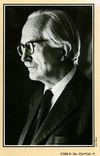The Empty House: Difference between revisions
imported>Hayford Peirce (→Plot: beginning to fill in the plot line) |
imported>Hayford Peirce (→Plot: changed a word) |
||
| Line 7: | Line 7: | ||
==Plot== | ==Plot== | ||
Written with Gilbert's usual urbane and understated style, the events mostly take place in the [[West Country]] of southwestern England, around the small cities and moors of [[Exmoor]] and [[Dartmoor]] and | Written with Gilbert's usual urbane and understated style, the events mostly take place in the [[West Country]] of southwestern England, around the small cities and moors of [[Exmoor]] and [[Dartmoor]] and its extremely dangerous seacoast. | ||
''The Empty House'' begins with the apparent death of Alexander Wolfe, a genius-level biologist working at the Biological Warfare Research Station under the supervision of the Western Command Headquarters at Exeter. His car has plunged off a cliff into the churning waters below, waters so turbulent that no thought is given to trying to recover the car or his body. | ''The Empty House'' begins with the apparent death of Alexander Wolfe, a genius-level biologist working at the Biological Warfare Research Station under the supervision of the Western Command Headquarters at Exeter. His car has plunged off a cliff into the churning waters below, waters so turbulent that no thought is given to trying to recover the car or his body. | ||
Revision as of 16:14, 4 September 2020
Authors [about]:
join in to develop this article! |
The Empty House is a novel of suspense by the British author Michael Gilbert published in England by Hodder and Stoughton in 1978 and in the United States by Harper & Row in 1979. It was Gilbert's 19th novel and does not fall into one neat category. Over his long career, Gilbert wrote many kinds of novels, from police procedurals to espionage thrillers, from courtroom dramas to chase and adventure, from cathedral and public school mysteries to tales of municipal corruption. Like the works of his near contemporaries Victor Canning and Ross Thomas, many of his works examined the amorality and sometimes lethal reactions of those in high government positions when confronted by events that run contrary to their wishes. The Empty House combines many of these elements in sometimes unexpected and startlingly violent ways.
Plot
Written with Gilbert's usual urbane and understated style, the events mostly take place in the West Country of southwestern England, around the small cities and moors of Exmoor and Dartmoor and its extremely dangerous seacoast.
The Empty House begins with the apparent death of Alexander Wolfe, a genius-level biologist working at the Biological Warfare Research Station under the supervision of the Western Command Headquarters at Exeter. His car has plunged off a cliff into the churning waters below, waters so turbulent that no thought is given to trying to recover the car or his body.
There is, nevertheless, a sharp edge to the entire story that is entirely in keeping with what one of Gilbert's American editors said about him after his death in 2006, many years after the publication of Flash Point:
"He's not a hard-boiled writer in the classic sense, but there is a hard edge to him, a feeling within his work that not all of society is rational, that virtue is not always rewarded.".[1]
Gilbert himself was a most Establishment figure, frequently writing about other Establishment figures, and was usually firmly on the side of England's police forces and shadowy (though lethal) Intelligent departments. But perhaps because of his many years of legal practice, he was also equally at home in filling his narratives with other types of characters: sleazy strip-club owners, tough and semi-crooked policemen, hard-bitten union officials, factory workers, relentless and unscrupulous Intelligent agents, and a wide variety of hard-boiled villains and crooks from small-time burglars and con men to gangster chieftains.
Reception
Newgate Callendar, . Nevertheless a strong, well‐written book.[2]
Notes
- ↑ Douglas Greene of Crippen & Landrau, quoted in The New York Times, 15 February 2006
- ↑ The New York Times, 19 January 1975 at https://timesmachine.nytimes.com/timesmachine/1975/01/19/76329705.html?pageNumber=251
